| Author |
Message |
Roger Hooper

|
 Posted: Fri 26 Apr, 2013 3:32 pm Post subject: Arms and Armor Custom Alexandrian Arsenal type XXa Sword Posted: Fri 26 Apr, 2013 3:32 pm Post subject: Arms and Armor Custom Alexandrian Arsenal type XXa Sword |
 |
|
Before describing the sword in question, I would like to put down a few facts about the Alexandrian Arsenal.
In 1365, Peter de Lusignan, king of Cyprus, and titular king of Jerusalem landed a force in Alexandria, Egypt in what is known as the Alexandrian Crusade, the shortest one on record. Peter had been going around various European courts stumping up support for an invasion of Palestine which would reinstate the Lusignans as Kings of Jerusalem in fact, not just in empty title. Finally, he was able to get a fleet of 165 ships from Venice, and along with some of the Knights of St. John, set sail for Alexandria. They looted the city, killed quite a few people, and after a few days, departed for home, leaving a small holding force behind. When the Mamluk army showed up, this force also departed, and that was the end of the Alexandrian Crusade.
There has been some argument about the purpose of this venture. Some say that it was intended as the first strike in a campaign to win back the Holy Land. Others say that Peter heard that the Mamluks were planning an attack on Cyprus, and decided to make a preemptive strike. And some say that it was a plan to destroy Alexandria as a thriving commercial port, so that trade could then be diverted to the Cyprian port of Famagusta. Whatever the motivation, it didn’t work, and thereafter things did not go very well for the Lusignans. Skirmishes and negotiations filled the next 75 years, mostly to the advantage of the Mamluks. In 1426 they invaded Cyprus, and brought back King Janos Lusignan as a captive. Cyprus had to pay a handsome ransom to get him back. During these years tribute and gifts were sent to Egypt, almost certainly including swords.
From 1367 to 1439 Frankish swords were deposited in the Arsenal at Alexandria. The blades are engraved with Naskhi script and typically say something like – Bequeathed in (the Islamic year by the current Mamluk Sultan) to the frontier city of Alexandria. At lease one also says, He who shall take it(and not return it) that will be imputed to him as a crime, which indicates that the arsenal, besides being a trophy hall, may have functioned as a sword lending library. Most of these swords came from tribute/negotiations/ransom from Cyprus, though some may have been battlefield loot. Some swords have signs of battle use on them, though it is not clear if that happened before or after their deposition into the Arsenal.
In 1517 the Turks conquered Egypt and removed the Alexandrian Arsenal swords to Istanbul, where they were installed in another arsenal in the former Church of St Irene. Sixty-two of them are still in Istanbul in the Askeri Museum. A fair number were sold, starting in the 19th century, and can now be found in private collections and museums in Europe and North America.
Of the surviving Alexandrian Arsenal Swords, there are a fair number of Oakeshott Type XIIIb’s (12, I think, all very similar to each other), XVIIIc’s, XIX’s, a few XVIa’s, and a scattering of a few other types. Among them, unique to the group, is a rather beautiful type XXa(?), the sword that Arms and Armor is re-creating for me.
|
|
  |
 |
Roger Hooper

|
 Posted: Fri 26 Apr, 2013 3:38 pm Post subject: Posted: Fri 26 Apr, 2013 3:38 pm Post subject: |
 |
|
When I was mulling over my next project with A&A, I first considered some swords in the Castillon group, also a XVIa with a finger-ring at the Museo Civico in Turin, plus a few others.. Then I came across a sword mentioned in a couple of articles in the Park Lane Arms Fair Catalogues: ”Some European Knightly Swords From the Arsenal of Alexandria”, by David Oliver (1999), and more extensively in “Father Of Victory”, by Clive Thomas (2008) It shares characteristics of more that one Oakeshott type – Oliver refers to it as “A late 14th century sword of almost Sempach form…”, which indicates type XVII to me. And it does have some similarities to that type. Thomas calls it a type XXa. At the guard it has a broad hexagonal section with two fullers that part way down merge into one. Where the single fuller ends, the blade transforms into a flattened diamond section, and at that point is actually thicker than it is at the guard. The width starts out at 2 inches and tapers sharply to an acute point. The blade is about 32.5 inches long with a hand-and-half hilt.(See Thomas’ extensive specs below) It is obviously a thrusting sword, but I imagine that it is an adequate cutter. It was put into the Alexandrian Arsenal around 1415, and was probably made around 1400 in Germany before traveling to Cyprus and then Egypt.
Thomas shows extensive specs and blade cross-sections in his article, and I thought it would be very interesting to see if a close re-creation could be done and how this sword might perform. I’m particularly interested in the blade geometry and how that will play out I considered substituting a curved type 11 guard and a T1 pommel (present on other XXa swords) but decided to go with the original combination. A&A is going through the process of creating this beauty and I hope to have it in hand in a month or two.
We haven’t yet worked out what the grip will look like. I have been trying to find representations of circa 1400 grips in art and tomb effigies without much success. If anyone is knowledge about that, I would much appreciate their input.
 Attachment: 90.79 KB Attachment: 90.79 KB

 Attachment: 55.88 KB Attachment: 55.88 KB

Photo courtesy of the Khalili Family Trust
 Attachment: 64.91 KB Attachment: 64.91 KB

Photo courtesy of the Khalili Family Trust
 Attachment: 97.21 KB Attachment: 97.21 KB
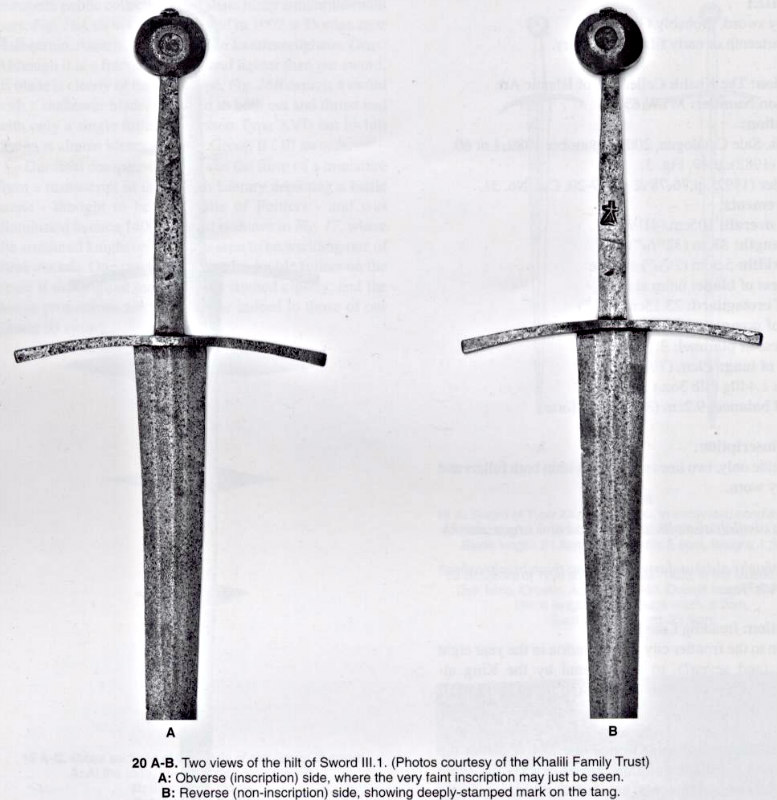
 Attachment: 96.78 KB Attachment: 96.78 KB
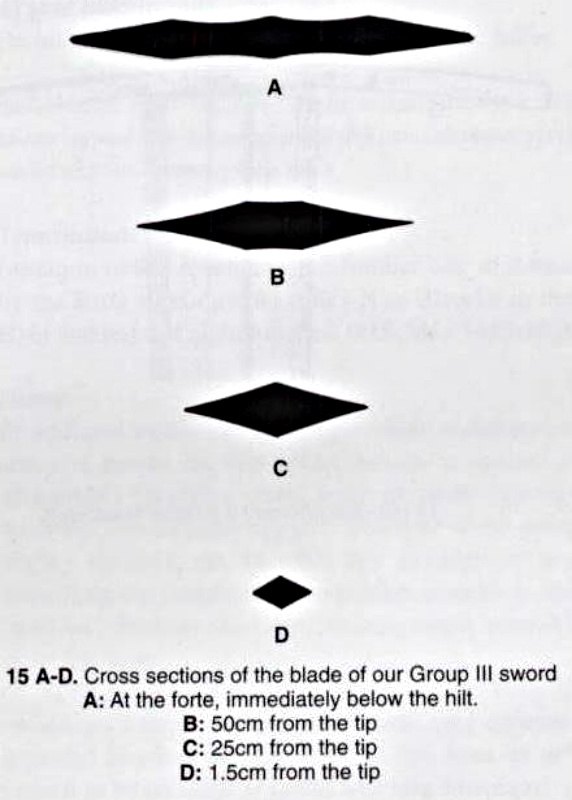
From "Father of Victory", by Clive Thomas
 Attachment: 94.64 KB Attachment: 94.64 KB
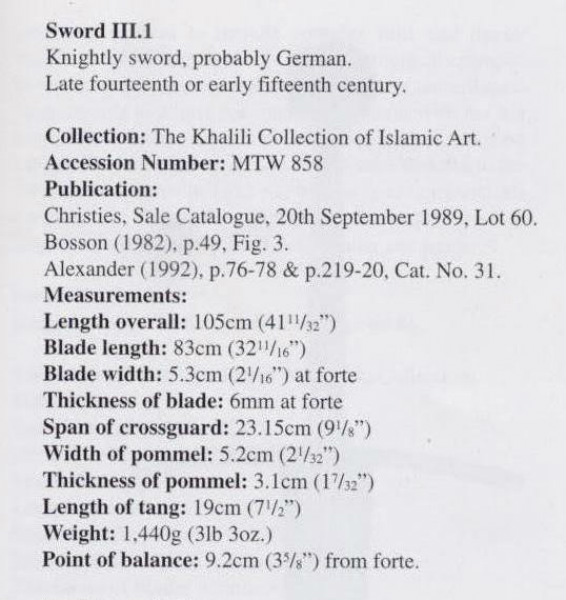
From "Father of Victory", by Clive Thomas
|
|
  |
 |
Kai Lawson

|
 Posted: Fri 26 Apr, 2013 4:38 pm Post subject: Posted: Fri 26 Apr, 2013 4:38 pm Post subject: |
 |
|
It doesn't look as short as the specs say--I was imagining something quite a bit larger. At just over 3 lbs with a 3+'' POB, combined with the longer grip and complex geometry, it looks like it will be a very handy, quick sword. The two fullers into 1 will look great too. Excellent pick
"And they crossed swords."
--William Goldman, alias S. Morgenstern
|
|
  |
 |
J.D. Crawford

|
 Posted: Fri 26 Apr, 2013 6:45 pm Post subject: Posted: Fri 26 Apr, 2013 6:45 pm Post subject: |
 |
|
Roger,
I recall you mentioning this one in the latest 'plans for next year' thread. That's a super cool sword with some very interesting blade geometry. Really looking forward to some pictures from A&A and your impressions.
Coincidentally my multifuller A&A project is coming together about the same time. They must be sitting withing a few feet of each other at the shop right now. We should get Craig to take some photos of them together.
Reading your historical background reminds me that I have a business trip to Istanbul next year and will have to visit the Askeri Museum. We have a few of those 'sold off swords' here in Toronto, a nice XIIIb in particular.
-JD
|
|
   |
 |
Roger Hooper

|
 Posted: Fri 26 Apr, 2013 7:47 pm Post subject: Posted: Fri 26 Apr, 2013 7:47 pm Post subject: |
 |
|
| J.D. Crawford wrote: | Roger,
Coincidentally my multifuller A&A project is coming together about the same time. They must be sitting withing a few feet of each other at the shop right now. We should get Craig to take some photos of them together.
-JD |
I think yours is a little further along. I've seen some fairly rough pictures of blade and guard, but there is still a lot to do.
|
|
  |
 |
|
Tim Lison
|
 Posted: Fri 26 Apr, 2013 11:07 pm Post subject: Posted: Fri 26 Apr, 2013 11:07 pm Post subject: |
 |
|
|
This one should be really cool when it's done. I like the blade a lot, it will be really nice to see it recreated. Keep us posted!
|
|
  |
 |
|
Scott Woodruff
|
 Posted: Fri 26 Apr, 2013 11:50 pm Post subject: Posted: Fri 26 Apr, 2013 11:50 pm Post subject: |
 |
|
AFAIK, there were no waisted grips qround 1400, so a simple tapered grip would probably be most appropriate. I think a tapered grip with spiral riser like Albion's Ljubljana would look really good with that blade and hilt furniture. Here are a few pics relevant to the end of the 14th beginning of the 15th century. I'll see if I can dig up some more for you. Awesome choice of sword to have replicated, I really look forward to seeeing the result. Do you plan on putting a guard-leather/rainguard/chape on it?
 Attachment: 84.75 KB Attachment: 84.75 KB
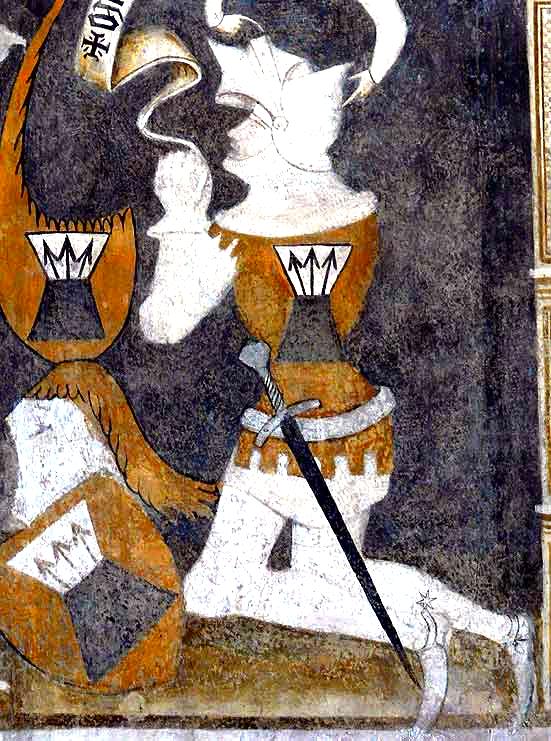
 Attachment: 27.22 KB Attachment: 27.22 KB

 Attachment: 142.09 KB Attachment: 142.09 KB
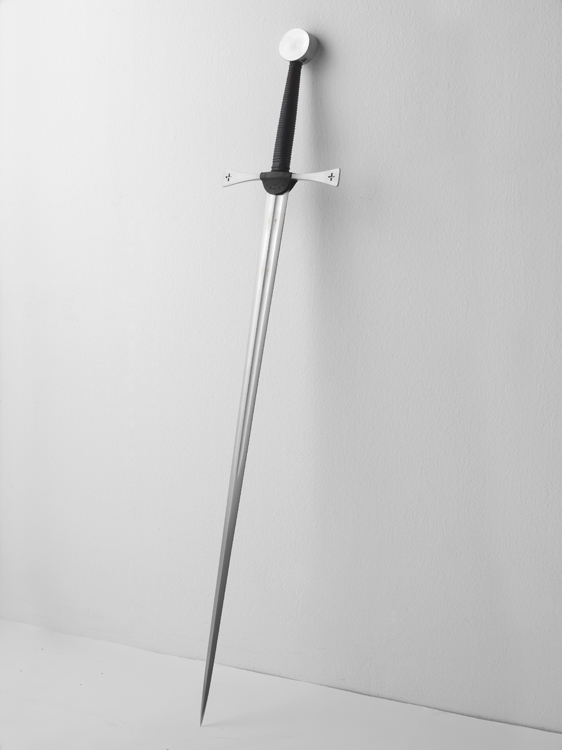
 Attachment: 47.84 KB Attachment: 47.84 KB
[ Download ]
 Attachment: 88.75 KB Attachment: 88.75 KB
[ Download ]
|
|
  |
 |
Roger Hooper

|
 Posted: Sat 27 Apr, 2013 7:52 am Post subject: Posted: Sat 27 Apr, 2013 7:52 am Post subject: |
 |
|
|
Thanks for the pictures, Scott. Sorry to hear that waisted grips weren't around at this period. That would have looked good on this sword. There are no plans to put a rainguard on to that hilt.
|
|
  |
 |
|
Eric W. Norenberg
|
 Posted: Sat 27 Apr, 2013 10:07 am Post subject: Posted: Sat 27 Apr, 2013 10:07 am Post subject: |
 |
|
The waisted grip did exist in the time period in question, most likely. Oakeshott's work gives us a some examples of waisted grips in the type XVIIIa family, dated to 1400-1450, one of them possibly as early as 1350, and all of them from Germany. Look at the spotlight article here:
http://www.myArmoury.com/feature_spotxviii.html
Scroll down to the extant examples photos, XVIIIa #1, 3, & 4. My point being only that waisted grips did likely exist around that time. But... ( and everybody I know has a big... uh...) I don't think it would be right on your sword, Roger. I'm not aware of any surviving grips in the type XX family from the period or any type XVII at all with that waisted profile. I'll second Scott's opinion that a grip like the Ljubljana would look smashing! You could probably even cheat a subtle swelling into the middle of the grip, to support the forward hand and give the profile a bit of that waisted sensuality without going too far into the realm of conjecture. But it would have to be subtle.
Anyhow... That is one gorgeous blade, and I too am excited to see the finished product, however the grip winds up! The cross section kinda puts me in mind of the Brescia Spadona. Any thoughts to the possibility that it might qualify as a double-fullered type XVIa? 
Cheers!
Eric
|
|
  |
 |
Roger Hooper

|
 Posted: Sat 27 Apr, 2013 11:47 am Post subject: Posted: Sat 27 Apr, 2013 11:47 am Post subject: |
 |
|
| Eric W. Norenberg wrote: | . Any thoughts to the possibility that it might qualify as a double-fullered type XVIa? 
Cheers!
Eric |
Clive Thomas shows 4 XVIa's in his article (Group II) He says that there are a number of similarities between them and the Group III sword, but there are enough differences for him to place it in a differant category. Interestingly, it has the same makers mark as the one on the XVIa's. It has the same hexangonal blade section morphing into flattened diamond as a XVIa, but its profile taper is much sharper. Again, I think this sword falls between part type chairs, with characteristics of XVIa, XVII and XXa.
A spiral grip with a swell towards the center is an attractive idea.
|
|
  |
 |
Roger Hooper

|
 Posted: Sun 28 Apr, 2013 12:10 pm Post subject: Posted: Sun 28 Apr, 2013 12:10 pm Post subject: |
 |
|
I’ve been thinking over the proportions of this unusual blade. Clive Thomas gives width and thickness specs only for the area at the guard, but when I measure the cross-section drawing and extrapolate from the given figures, I get the following – mm (inches)
Total Blade Length – 830 mm (32.677 inches)
Point A – just below the guard
Blade Thickness – 6 mm (.236 inches)
Blade Width – 53 mm (2.087 inches)
Point B – 500 (19.685) from blade tip
Blade Thickness – 6 (.236)
Blade Width – 35 (1.378)
Point C – 250 (9.843) from the tip
Blade Thickness – 7 (.276)
Blade Width – 24 (.945)
Point D – 15 (.590) from the tip
Blade Thickness – 4 (.158)
Blade Width – 8 (.315)
As you go down the blade it gets thicker and narrower, until at Point C, 70% down from the guard (presumably where the shape shifts from hexagonal to diamond), it is 15% thicker and 55% narrower. One conclusion is that the sword is a stiff thruster, and probably won’t cut that well. You might think that it could be blade heavy, but the POB is 92 (3.625) down from the guard. Note that this sword has a large, heavy pommel, so that may pull the POB back a little.
I’m very curious as to how this sword will turn out. Will it be beautifully balanced for its purpose or will it be a clunker? Note that I'm mathematically stupid and my calculations could be offbase.
Edited to change the thickness dimension for B, C, and D. I was able to get a better size on that cross-section picture. I'm still not sure about the absolute accuracy of that picture. Still the new measurements show a much less extreme distal taper increase (from 34% to 15% increase from A to C thickness).
|
|
  |
 |
Roger Hooper

|
 Posted: Tue 28 May, 2013 5:16 pm Post subject: Posted: Tue 28 May, 2013 5:16 pm Post subject: |
 |
|
Here are two photos from A&A of the nearly finished sword -
I was tempted to go overboard with the grip shape, but decided to be a little more restrained. The grip is 7.125 long.
It looks like a good thrust and cut sword.
 Attachment: 100.16 KB Attachment: 100.16 KB
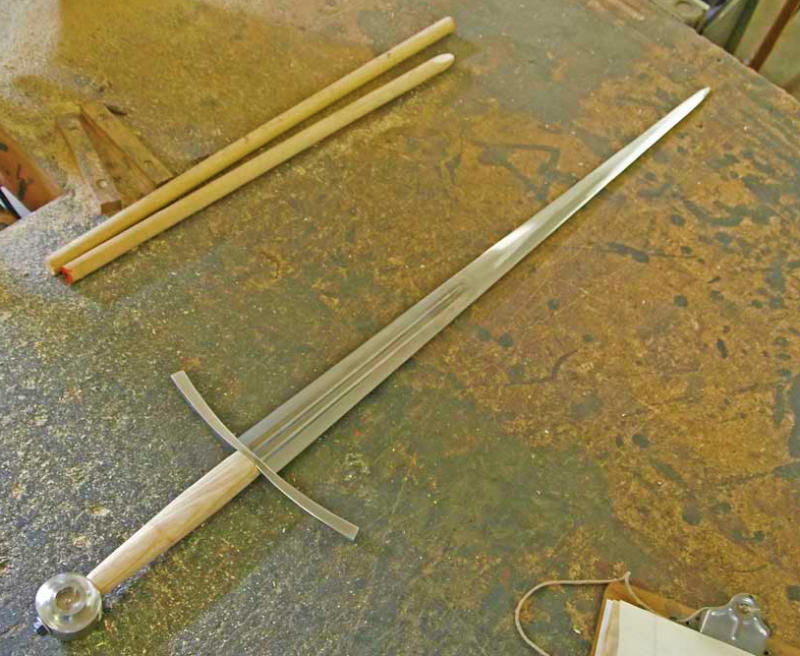
 Attachment: 98.81 KB Attachment: 98.81 KB

Last edited by Roger Hooper on Tue 28 May, 2013 5:21 pm; edited 1 time in total
|
|
  |
 |
|
Tim Lison
|
 Posted: Tue 28 May, 2013 5:20 pm Post subject: Posted: Tue 28 May, 2013 5:20 pm Post subject: |
 |
|
|
That looks really nice. A&A sure do fine work! I think the grip you chose is really appropriate and very stylish! Looking forward to seeing this one done!
|
|
  |
 |
Roger Hooper

|
 Posted: Sat 08 Jun, 2013 9:56 am Post subject: Posted: Sat 08 Jun, 2013 9:56 am Post subject: |
 |
|
Here are some photos from A&A, showing the completed grip. It turned out very well. It has a shade of blue that is actually blue, not virtually black as often happens. It's a hue that some here may not care for, but I like it.
The sword isn't yet peened, but soon will be. Also, the scabbard isn't finished. I should have it in hand pretty soon 
 Attachment: 100.25 KB Attachment: 100.25 KB

Another A&A Still Life With Sword
 Attachment: 93.18 KB Attachment: 93.18 KB
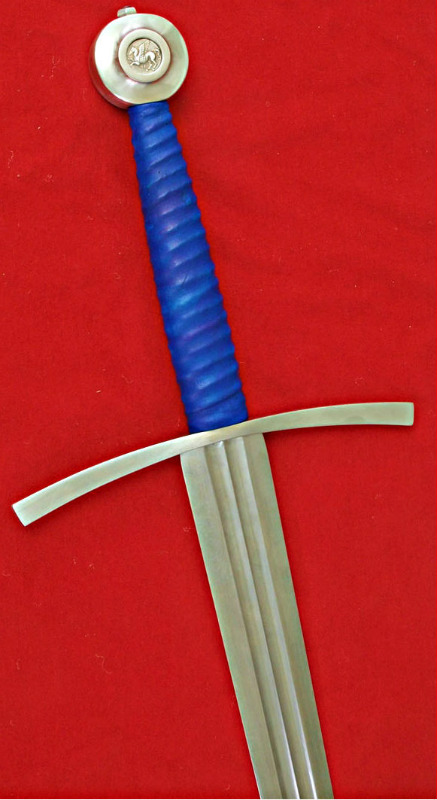
Photo from A&A
|
|
  |
 |
William Swiger

|
 Posted: Sat 08 Jun, 2013 10:08 am Post subject: Posted: Sat 08 Jun, 2013 10:08 am Post subject: |
 |
|
|
Beautiful sword. Congratulations!
|
|
  |
 |
J.D. Crawford

|
 Posted: Sat 08 Jun, 2013 10:27 am Post subject: Posted: Sat 08 Jun, 2013 10:27 am Post subject: |
 |
|
| Roger Hooper wrote: | | It's a hue that some here may not care for, but I like it. |
Royal blue suits a sword of such royal proportions and quality.
By the way, I don't think that grip will be slipping in your hands, no matter what sort of armor you thrust against!
The horse and rider in the pommel recess are also a nice touch and very well executed - is that derived from the original (hard to see in the photos) or was this a special request?
|
|
   |
 |
Roger Hooper

|
 Posted: Sat 08 Jun, 2013 10:53 am Post subject: Posted: Sat 08 Jun, 2013 10:53 am Post subject: |
 |
|
Here is a drawing from around 1400 that Clive Thomas includes in His "Father of Victory" article. He says that it shows a sword of this type. It does look very much like the III.1. Curious how that dagger is piercing right through the breastplate. Artistic License?
Thomas says in this article, "...the blade has many nicks, cuts, and notches along its length, indicating a very well-used fighting sword". Would a sword in this used condition be part of a gift or tribute package? This indicates to me that -
1) It was battlefield loot, not tribute
Or
2) It acquired those usage marks from being lent out from the Arsenal to various Mamluks
 Attachment: 96.23 KB Attachment: 96.23 KB
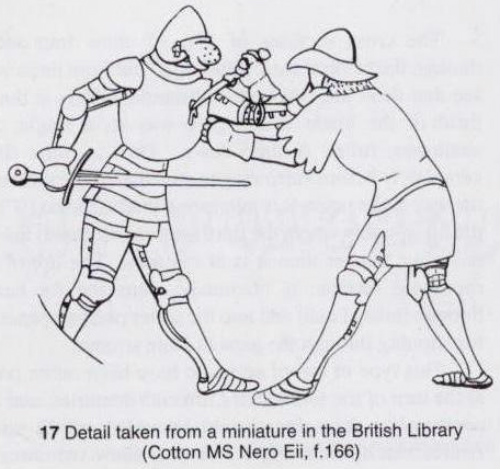
From "Father of Victory", by Clive Thomas in 2008 Park Lane Arms Fair Catalogue
Last edited by Roger Hooper on Sun 09 Jun, 2013 9:17 am; edited 1 time in total
|
|
  |
 |
|
Jeremy V. Krause
|
 Posted: Sun 09 Jun, 2013 7:03 am Post subject: Posted: Sun 09 Jun, 2013 7:03 am Post subject: |
 |
|
Beautiful sword. It will be nice to see it in hand for scale.
I like the bold grip color!
|
|
  |
 |
Peter Anderson

Location: Holland, USA Joined: 22 Mar 2013
Posts: 38
|
 Posted: Sun 09 Jun, 2013 11:40 am Post subject: Posted: Sun 09 Jun, 2013 11:40 am Post subject: |
 |
|
|
I for one am quite fond of that colour, and indeed the inset decorative panels in the pommel. Magnificent!
|
|
  |
 |
Roger Hooper

|
 Posted: Sun 09 Jun, 2013 5:31 pm Post subject: Posted: Sun 09 Jun, 2013 5:31 pm Post subject: |
 |
|
Please forgive the long post. I'm kind of obsessed with the detailsof this sword.
You may be curious about the coins mounted in the pommel insets. To answer J.D.’s question, there was nothing mounted in the original's pommel recesses, or if there was, it got removed. I felt that they were spaces begging to be filled. They are silver replicas (you can also get them in tin – much cheaper) made by Antiqua Nova Mint in the Czech Republic. They make Greek, Roman, Medieval coins, and are just about the best in the world at doing that.
I picked two very similar ancient Corinthian silver staters, the originals dating from between 400 to 350 B.C. The obverse shows Pegasus, the winged horse, and the reverse has Athena, wearing a pushed back Corinthian helmet. This is a very common motif for coins from this city – there are quite a few of them still around.
You may wonder why these two are on a coin from this city. After all, Athena is closely associated with Athens and her head is on almost all Attic coins (wearing a different style helmet), with an owl on the reverse. OK, here is the relevant myth –
The Corinthian prince, Bellerophon had been given a heroic task to accomplish (killing the Chimera) and felt that he needed the assistance of Pegasus to bring it off. Under advice, he slept in Athena’s temple, hoping for a prophetic dream. Athena appeared to him, gave him a golden bridle, and told him to go get Pegasus at the spring of Pirene on Acrocorinth. Bellerophon awoke with the bridle beside him. He went to Pirene , harnessed up the waiting Pegasus, and flew off to slay the Chimera (thus ending a promising sword line from Christian Fletcher) Bellerophon went on to do more heroic deeds until he got a case of hubris. He attempted to fly Pegasus to Mt. Olympus, but the gods cast him down. He fell to earth, and spent the rest of his life a broken man. So Athena and Pegasus are on the coin, but not Bellerophon. I don’t think that mortals were pictured on coins before Philip of Macedon.
Was an ancient Greek coin an appropriate item to mount onto a Medieval sword? Here is my reasoning –
1) I really wanted to do it. Ancient Greek coins are IMO the most beautiful ever made.
2) I’ve never heard of any with Greek coins, but there are swords sporting Roman coins, for instance Oakeshott’s, Records XIIIb.2
3) This sword spent some time on Cyprus. Corinthian coins had a wide circulation around the Mediterranean, and there were surely some to be found on Cyprus
The Lusignan court on the island prided itself on how French it was, very faithful to the Latin Church. They probably would have looked with disfavor on a sword with a pagan goddess in the pommel. But I picture a Westerner who, before going on to Cyprus, had spent some time in the soon to be extinguished Frankish kingdoms in Attica and the Peloponnese, where he broadened his horizons. Anyone who has read the Iliad knows that Athena is the goddess to have by your side, in your chariot. Just ask Diomedes and Odysseus.
 Attachment: 96.69 KB Attachment: 96.69 KB
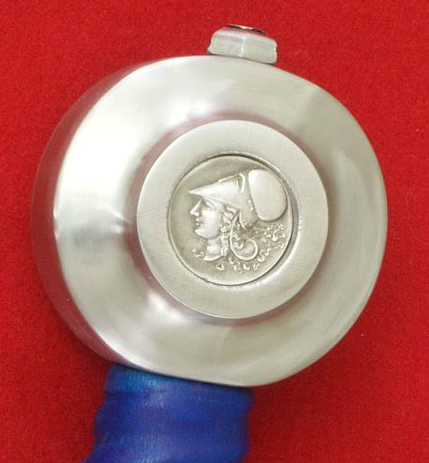
Athena
 Attachment: 90.04 KB Attachment: 90.04 KB
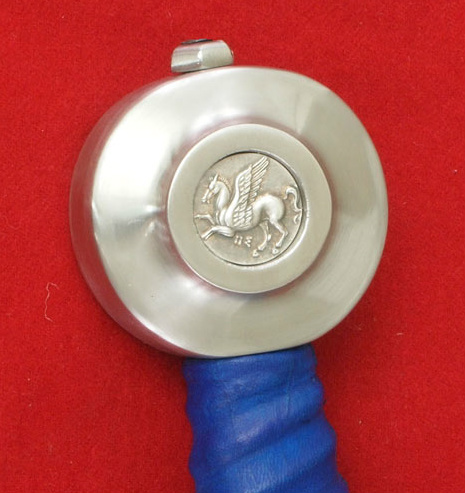
Pegasus
 Attachment: 43.52 KB Attachment: 43.52 KB
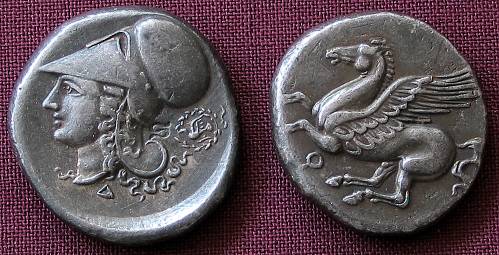
Used this Athena - more Attitude
 Attachment: 39.68 KB Attachment: 39.68 KB
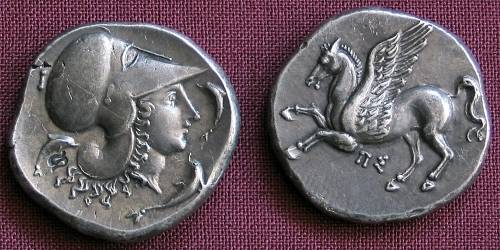
Used this Pegasus - sharper definition
|
|
  |
 |
|
|
You cannot post new topics in this forum
You cannot reply to topics in this forum
You cannot edit your posts in this forum
You cannot delete your posts in this forum
You cannot vote in polls in this forum
You cannot attach files in this forum
You can download files in this forum
|
All contents © Copyright 2003-2025 myArmoury.com — All rights reserved
Discussion forums powered by phpBB © The phpBB Group
Switch to the Basic Low-bandwidth Version of the forum
|

